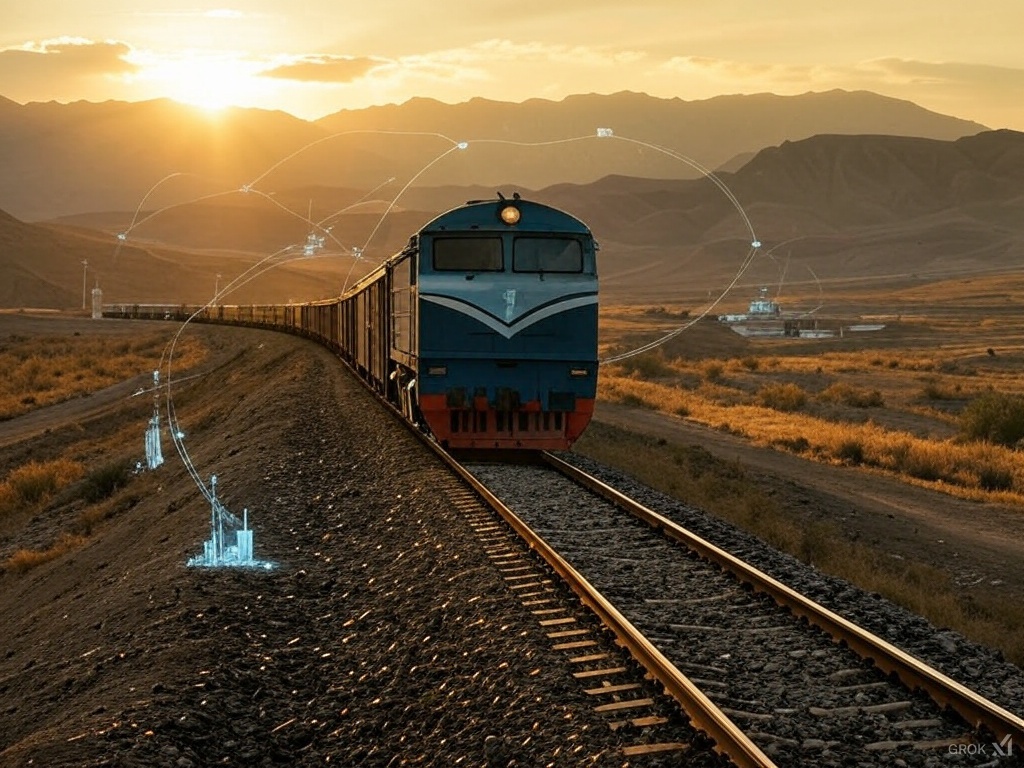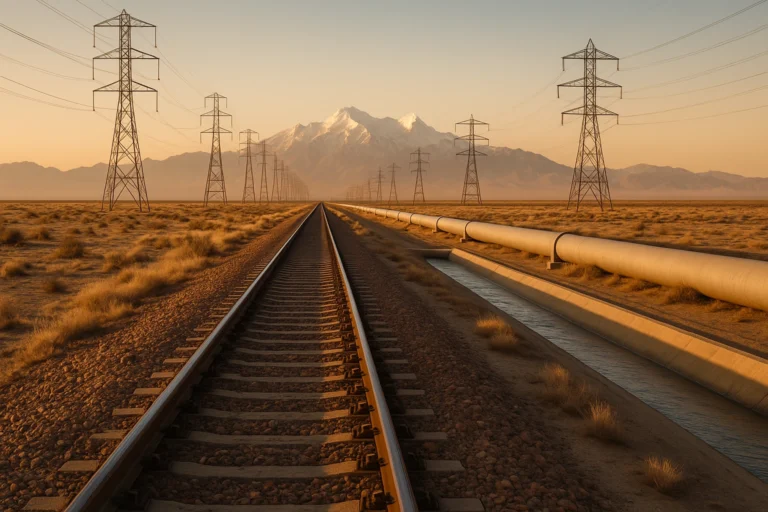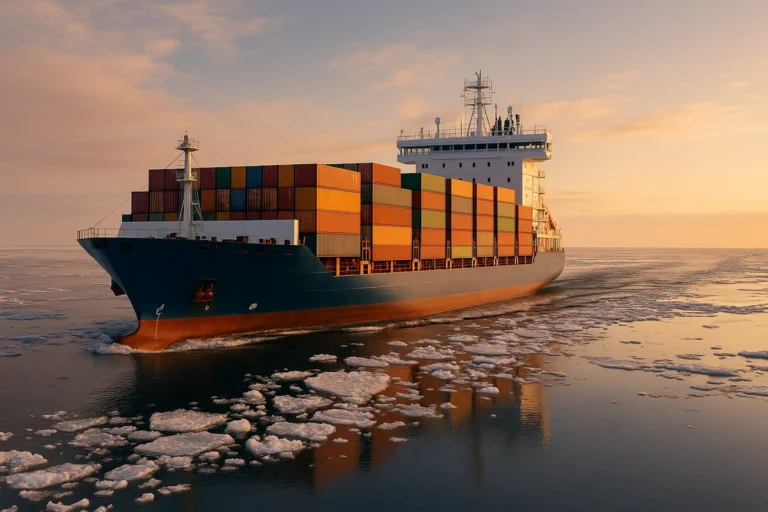
Afghanistan is becoming a trade crossroads, with new rail and road corridors linking Central Asia to South Asian ports and reshaping regional dynamics.
An Unlikely Transit Revival in Afghanistan
In September 2024, officials from Turkmenistan, Kazakhstan, and Afghanistan met at the remote border post of Torghundi to lay the foundation of a new railway line. The modest 22-kilometer segment—connecting Torghundi to the nearby hamlet of Sanobar—was a small piece of track with outsized symbolism. It marked an unlikely milestone: war-torn Afghanistan’s emergence as a pivotal land bridge between Central and South Asia. After decades defined by conflict, the country’s Taliban-led government is spearheading a quiet revolution on the rails and roads. A series of ambitious transport projects is turning Afghanistan into a transit hub, stitching together networks that promise to transform regional trade and geopolitics. The push has garnered broad regional support, opening a new chapter in Afghanistan’s relationship with its neighbors.
The vision of Afghanistan as a crossroads of Asia is rapidly taking shape. Once seen as a dead end on the map, the nation now hosts competing railway initiatives backed by eager neighbors. Uzbekistan and Turkmenistan – traditionally rivals in Central Asia – are each advancing their own rail corridors across Afghan territory to reach Pakistan’s warm-water ports. This race to the sea is more collaborative than cutthroat: the competition has spurred both countries to accelerate construction and offer flexible tariffs to attract cargo, driving down transport costs for all. For landlocked Central Asian republics, these new routes through Afghanistan offer a tantalizing shortcut to global markets, reducing dependence on longer roads via Iran or the Caucasus. For Afghanistan, they signal a strategic rebranding from battleground to bridging nation.
Key Developments: Corridors and Collaborations
Afghanistan’s transport infrastructure is progressing at a pace few expected just a couple of years ago. In May 2023, Afghan authorities approved the Mazar-i-Sharif–Herat–Kandahar railway, a 1,468 km line designed to link the country’s north and west. By mid-2024, plans were announced to extend this line southward with a new Spin Boldak–Kandahar segment, effectively plotting a rail connection from Uzbekistan’s border all the way to Pakistan. Turkmenistan swiftly responded with its own Trans-Afghan rail proposal, pitching a route from its border at Torghundi through Herat and Kandahar to Spin Boldak. Notably, Kazakhstan joined this western corridor initiative at Ashgabat’s invitation, and the first rails were laid on the Turkmen-Afghan border in late 2024. Thus, two parallel steel pathways – an eastern “Kabul Corridor” via Uzbekistan and a western corridor via Turkmenistan – are now vying to funnel goods across Afghanistan.
Crucially, Afghanistan’s neighbors have not let politics stand in the way of progress. Despite initial uncertainty after the Taliban takeover in 2021, nearly all regional infrastructure projects have been reactivated under Afghanistan’s new rulers. The Taliban government, seeking economic lifelines, has proven unexpectedly pragmatic – resuming work on railways, highways, and energy links that connect Afghanistan outward. Announcements have been made to launch the remaining segments of the Turkmenistan–Afghanistan–Tajikistan (TAT) corridor, including the Andkhoy–Sheberghan and Sheberghan–Mazar-i-Sharif rail lines, as well as the long-envisioned Mazar-i-Sharif–Herat link. Even Tajikistan, which has had frosty relations with Kabul’s new regime, is cautiously coming on board. In July 2024, Dushanbe agreed with South Korean aid agency KOICA to study a 51 km railway from Tajikistan’s southern border to Sher Khan Bandar, Afghanistan. That short spur would complete Tajikistan’s connection into the TAT network, finally giving the country a direct route south through Afghanistan. For a nation that until recently bristled at Taliban rule, this was a significant step, underlining how economic interests are trumping political grudges in Central Asia’s new connectivity push.
Recent milestones on the ground underscore the momentum. Over the summer, pilot freight convoys successfully traversed the trans-Afghan route. In one trial, goods from Pakistan’s port of Karachi were trucked through Afghanistan and Central Asia all the way to Azerbaijan’s capital Baku in just 21 days, moving via the Torkham border, Kabul, Uzbekistan’s Termez logistics hub, and Kazakhstan’s Caspian Sea port of Aktau. The 4,800+ km journey demonstrated the viability of Afghanistan as a corridor linking South Asia to the Caucasus and Europe. Likewise, Kazakhstan sent test shipments southward, dispatching containers from Almaty through Uzbekistan and Afghanistan to Karachi in about 20 days. These dry runs, part of a “Trans-Afghan Multimodal Corridor” pilot, have given neighboring countries a tangible taste of the benefits to come. Each successful delivery builds confidence that Afghanistan’s roads and rails can indeed serve as reliable arteries of commerce.
Central Asia’s Stakes: Opportunity and Caution
For Central Asian countries, Afghanistan’s transport revival opens a mix of opportunities and challenges. Economic prospects are clear: new transit corridors promise shorter, cheaper routes to lucrative markets. Landlocked Uzbekistan, for instance, would gain direct rail access to Pakistan’s Arabian Sea ports, boosting its export potential and reducing dependence on long detours via Iran or Russia. Lower transportation costs due to the launch of additional routes across Afghanistan could significantly improve the competitiveness of Central Asian goods. Countries like Kazakhstan and Kyrgyzstan, which lie further north, see the Afghan corridors as a chance to diversify supply lines and reach South Asia and the Middle East more efficiently. Kazakhstan’s participation in the trans-Afghan railway and its freight pilots reflect a strategic bet on southern outlets for its grain, minerals, and oil. Kyrgyzstan, which is part of the planned five-nation route to Iran, could likewise break out of its geographic isolation if rail links through Tajikistan and Afghanistan to China and the Persian Gulf materialize.
Politically, the situation is more delicate. Embracing Afghanistan as a transit hub has required Central Asian governments to engage with the Taliban regime—a pragmatic pivot driven by national interest. Most have done so readily: Uzbekistan, Turkmenistan, and Kazakhstan have all intensified diplomatic and trade contacts with Kabul, focusing on connectivity and commerce while sidestepping thornier issues. Tajikistan remains an outlier; it was initially the lone Central Asian state refusing formal ties with the Taliban government. Yet even Tajikistan has softened its stance in practice, quietly cooperating on corridor studies and keeping communication open via third parties. The overall trend is one of Central Asia strengthening economic bonds with Afghanistan, hoping that interdependence will bring stability. As one senior Central Asian diplomat put it, “We cannot change our neighbor, so we are building rails and roads to connect with them instead.”
The geopolitical stakes are high. Should Afghanistan firmly establish itself as a transit linchpin, the balance of power in regional trade could shift. Uzbekistan, traditionally Central Asia’s gateway state, faces the prospect of its neighbors finding ways around it. If the Turkmenistan-Afghanistan-Tajikistan route (via Herat and Kunduz) is completed, Tajikistan and Kyrgyzstan would no longer be solely reliant on Uzbek railways to access global markets. Iran, too, stands to gain strategically: a rail corridor running from China through Kyrgyzstan, Tajikistan, and Afghanistan to Iran’s eastern border would bypass the land routes controlled by Uzbekistan and Kazakhstan, potentially reducing those countries’ leverage over regional transit. Such developments could redraw the competitive landscape. Uzbekistan, which invested early in the Kabul corridor to assert itself in regional logistics, is now warily eyeing alternative tracks being laid to its west. Tashkent sees the completion of the Turkmenistan-backed routes as a serious challenge to its transit primacy.
At the same time, all Central Asian states recognize that improved connectivity is a rising tide that could lift all boats. The region’s GDP and trade volumes could get a welcome boost from easier access to Pakistani, Indian, and Middle Eastern markets. To realize these gains without sparking conflict, Central Asian leaders are treading a fine line. They are coordinating policies and discussing how to harmonize tariffs, customs, and investments so that new corridors complement rather than undercut each other. There is talk of forming a regional transport consortium or working through existing bodies like CAREC (Central Asia Regional Economic Cooperation) to ensure fair transit fees and cargo sharing. The consensus is that competition can be healthy – up to a point. “We need multiple routes, but not a zero-sum game,” a Central Asian transport official commented. This underscores the prevailing view that while Afghanistan’s rise as a transit hub brings competition, it also mandates cooperation. To avoid rivalry spilling over, the five republics of Central Asia may need to formulate a coordinated strategy on interregional corridors, balancing their interests as Afghanistan’s role grows. In essence, they must adapt to the new reality of Afghanistan as an economic partner at the heart of their neighborhood.
Global Context: The Corridor Great Game
Afghanistan’s transport initiatives are unfolding against the backdrop of a broader global infrastructure race. In the past decade, connectivity has become a geopolitical buzzword, with major powers vying to build roads, rails, and ports to secure influence. China’s expansive Belt and Road Initiative (BRI) has poured hundreds of billions into Eurasian corridors, from railways in Kazakhstan to highways in Pakistan. While Afghanistan received little investment under BRI during the two decades of U.S.-backed government, Beijing is now eyeing the country as a missing piece in its Eurasian jigsaw. China’s special envoy to Kabul has openly supported Afghanistan’s rail projects – including the Uzbekistan–Kabul–Peshawar line – noting that such mega projects would “contribute to lasting peace…and strengthen regional interconnectedness. Beijing sees Afghanistan as a bridge linking Central and South Asia.” In fact, just months before the Taliban takeover, China, Uzbekistan, and Pakistan had agreed on the framework of the 573 km Trans-Afghan railroad, estimated then at around $5 billion. With Western aid to Afghanistan now largely frozen, Chinese backing for these projects has grown even more pivotal. Beijing’s interest is not purely altruistic: a stable transit route through Afghanistan could eventually carry Chinese goods from Kashgar to the Middle East and bring Afghan minerals to China. In the larger BRI network, it would knit together the northern corridors in Central Asia with the southern corridors of Pakistan and Iran, creating a more integrated Eurasian trade grid.
Western countries, for their part, are promoting alternative connectivity visions, though often outside of Afghanistan due to the political complexities. The G7’s Partnership for Global Infrastructure and Investment (PGII) and the EU’s Global Gateway initiative have earmarked funds for infrastructure in developing regions, including Central Asia. In 2024, the EU announced a €10 billion plan to support transport links in Central Asia – a clear nod to providing options beyond reliance on China or Russia. Separately, the United States, European Union, India, and Middle Eastern partners unveiled the concept of an India–Middle East–Europe Economic Corridor in late 2023, a grand multimodal route connecting South Asia to Europe via the Arabian Gulf. Though that particular corridor bypasses Central Asia entirely, it underscores the current zeitgeist: global powers are in a scramble to connect markets and secure supply chains, and geography is being rewritten by steel and concrete.
Where does Afghanistan fit into this connectivity contest? Arguably, it is becoming a prime arena where the interests of China, Russia, Iran, and the West overlap and sometimes collide. Russia, historically the region’s infrastructural patron, has also expressed renewed interest in Afghan routes as sanctions push Moscow to seek new trading avenues to South Asia. Iran is energetically pursuing its “Five Nation Railway” vision linking to China through Afghanistan, partly to outflank rival routes like the Trans-Caspian corridor that skip Iranian territory. And while Western nations remain diplomatically distant from Kabul’s current rulers, they quietly acknowledge the potential of Afghanistan’s connectivity – if it can be realized without empowering extremist elements. The defunct U.S.-backed idea of a “Lapis Lazuli Corridor” – which would have connected Afghanistan overland to Turkey and Europe – is seeing a de facto revival through these new projects, now driven by regional players rather than Washington or Brussels. In essence, Afghanistan’s transport push aligns with global trends exemplified by BRI, yet it is uniquely shaped by local geopolitics. The country sits at the crossroads of multiple grand schemes, from China’s westward expansion to Russia’s Eurasian integration plans and Western efforts to foster stable trade routes that avoid adversaries. Connectivity has become the new great game, and Afghanistan finds itself, perhaps for the first time in decades, holding some promising cards.
Quick Insights: Key Takeaways
- Afghanistan as a Transit Hub: Once isolated by conflict, Afghanistan is now positioning itself as a vital transit corridor linking Central Asia with South Asian ports, dramatically shortening regional trade routes.
- Surging Infrastructure Projects: Multiple railway and road projects are underway – from the 573 km Uzbekistan–Afghanistan–Pakistan rail line to Iran-backed routes toward Herat – indicating broad international collaboration despite Afghanistan’s political challenges.
- Central Asian Participation: Uzbekistan, Turkmenistan, Kazakhstan, and even a wary Tajikistan are investing in trans-Afghan corridors, seeking economic gains from lower transport costs and new market access while balancing competition and cooperation.
- Geopolitical Dynamics: These corridors could reshape regional power balances. Landlocked nations like Tajikistan and Kyrgyzstan may gain alternatives to traditional routes, reducing reliance on neighbors, while powers like China and Iran stand to extend their strategic reach through Afghan links.
- Opportunities vs. Risks: Improved connectivity promises trade growth, revenue, and integration for Afghanistan and its neighbors. However, success hinges on political stability, security, and sustained cooperation – without which financing and executing these grand projects will remain a daunting challenge.
What’s Next? Future Outlook and Risks
Looking ahead, Afghanistan’s nascent role as a transit hub faces both promising opportunities and formidable uncertainties. In the near term, the focus is on execution: surveys and feasibility studies must translate into construction contracts and on-the-ground work. Officials in Kabul claim that major rail links – like the Kabul–Peshawar line – could be completed within a few years if funding is secured. A key question is who will bankroll these multibillion-dollar projects. China is a leading contender, potentially through the Belt and Road framework, especially if it sees a stable environment to protect its investment. Beijing’s ongoing engagement and recent agreements hint that Afghanistan may formally join the BRI network, unlocking Chinese infrastructure loans and expertise. Similarly, Gulf states and development banks could come forward to fund pieces of the corridor puzzle, motivated by the prospect of new trade opportunities and political influence. There is even speculation that India – which has historically avoided dealing with the Taliban – might support certain projects (like Iran’s port and rail link through Herat) to strengthen trade connectivity with Central Asia, all as part of its broader “Connect Central Asia” policy.
However, risks abound on this road to connectivity. Security remains the elephant in the room. While the Taliban have largely consolidated control and reduced internal fighting, insurgent groups such as ISKP (Islamic State Khorasan Province) continue to pose a threat. Any high-profile infrastructure, especially one involving foreign stakeholders, could become a target for terrorist attacks or local banditry. A single incident on a train or convoy could spook investors and insurers, derailing confidence in the routes. Moreover, the Taliban government itself faces questions of long-term stability and international legitimacy. A lack of formal recognition and ongoing sanctions mean Afghanistan is cut off from many forms of international financing. This could slow progress unless workarounds are found, such as partnerships through neighboring countries or private sector deals. There’s also the risk of overlapping projects leading to a glut of capacity: if both the Uzbek-led and Turkmen-led rail corridors are built, plus Iran’s route and possibly parallel highways and pipelines (like the long-delayed TAPI gas pipeline), managing all these and attracting sufficient cargo will be a juggling act. Too many routes chasing too little trade would hurt everyone.
On the horizon, several trends bear watching. First, the pace of Central Asian cooperation with Afghanistan is likely to increase. Regional forums might soon treat Afghanistan as an integral part of Central Asia’s economic space rather than an adjunct. We may see new trilateral or quadrilateral agreements – for example, between Russia, Kazakhstan, Uzbekistan, and Afghanistan – to coordinate rail schedules or customs policies. Second, if the political climate improves, Western nations could cautiously re-engage in Afghanistan’s connectivity efforts. The European Union, for instance, might find ways to support infrastructure that also serves its interests in Central Asia, perhaps under humanitarian or development guises that bypass direct funding of the Taliban. The United States and its G7 partners could likewise back select initiatives (such as power transmission lines or digital infrastructure) that complement the physical corridors, ensuring they are not completely outflanked by China’s influence. Finally, Afghanistan’s own capacity to manage a burgeoning transit economy will be tested. As transit fees, customs revenue, and logistics services become a bigger part of its GDP, there will be pressing needs for skilled personnel, transparent regulations, and maintenance of infrastructure. How the Taliban administration adapts – whether it can evolve from an insular militia leadership to savvy trade facilitators – will significantly determine the sustainability of Afghanistan’s transit role.
In a best-case scenario, five years from now Afghanistan could be a thriving overland conduit, with freight trains rumbling across its plains and convoys carrying goods from Karachi to Almaty routinely. Such connectivity would spur not only trade but also potentially peace, as Afghanistan gains a stake in stability and its neighbors gain a stake in Afghanistan. The more sobering scenario is one where progress stalls – perhaps due to a security incident or waning investor interest – leaving half-built rails in the desert. Most likely, the outcome will lie somewhere in between: incremental advances on some routes, delays on others, and constant negotiation to keep all players on board. What’s certain is that Afghanistan’s geographic fate as a crossroads is now being actively tested. The coming years will show whether it can truly convert that geography from a curse into an asset, changing the narrative from one of perpetual conflict to one of connectivity and commerce.
Regional Spotlight: Winners, Losers, and Bystanders
The impact of Afghanistan’s transport push is not uniform across Central Asia – each nation in the region has its own stake and strategy:
Uzbekistan: As the driving force behind the Trans-Afghan railway via Kabul, Uzbekistan stands to gain a critical direct route to the sea. Tashkent’s vision of a rail link to Pakistani ports would bolster its role as a trade hub and unlock faster access to Middle Eastern and African markets. Uzbekistan was quick to court the Taliban government on this issue, securing pledges of cooperation for the 573 km railway project. However, Uzbekistan also faces the strategic downside of losing its near-monopoly over regional transit. If parallel corridors – like the one from Turkmenistan to Pakistan – draw traffic away, Uzbekistan could see transit revenues and influence diluted. Balancing its own corridor initiative with support for a broader network will be a key diplomatic challenge for Tashkent. So far, it has actively convened regional meetings (such as a May 2024 conference in Termez) to keep stakeholders committed. For Uzbekistan, success in Afghanistan could be a double-edged sword: delivering prosperity but also inviting more competition right at its doorstep.
Turkmenistan: Long relatively isolated, Turkmenistan has emerged as a major proponent of trans-Afghan connectivity – but on its own terms. By championing the western route through Herat and Kandahar, Turkmenistan aims to secure a new pathway to the Indian Ocean that complements its existing corridors to Iran and the Caspian. Ashgabat’s quick move to propose the Torghundi–Herat–Spin Boldak railway and involve Kazakhstan signals its intent to lead on regional transit, leveraging Afghanistan to reach Pakistan and beyond. Success would enhance Turkmenistan’s position as a crossroads (linking Central Asia not just east-west, but now north-south). It would also boost its export options for natural gas and commodities via Pakistani or maybe Indian markets. Turkmenistan’s challenge is partly financial – these projects are costly – and partly about security, since its route traverses areas in western Afghanistan that have seen occasional unrest. Nonetheless, Turkmenistan has the advantage of a working relationship with Iran, meaning it can integrate the trans-Afghan rail with the Iranian network (for example, via the Mashhad–Sarakhs line into Turkmenistan). In sum, Turkmenistan could transform from a cul-de-sac economy into a transit linchpin if the Afghan corridor comes to fruition.
Tajikistan: Among Central Asian states, Tajikistan has been the most hesitant toward Afghanistan’s new rulers, but it arguably has the most to gain from new routes. Tajikistan is geographically boxed in by its neighbors and towering mountains, with very limited transport access to world markets. A completed TAT railway through Afghanistan would give Tajikistan a long-sought direct outlet to the south, connecting it through Afghan rail to Pakistan’s ports or to Iran via Herat. This could reduce Tajik dependence on Uzbekistan’s rail network for overseas trade. Dushanbe’s recent cooperation on feasibility studies for the Afghan link indicates a pragmatic shift. However, Tajikistan faces serious hurdles: it lacks the capital to invest heavily and will rely on external financing (likely Chinese) to build its portion of any corridor. Moreover, political distrust lingers – Tajikistan fears instability or militancy emanating from Afghanistan, given past incursions. The Tajik leadership will likely proceed slowly and seek security guarantees as it edges into partnership with the Taliban regime. If trust and funding can be managed, Tajikistan stands to be a big winner – turning from a landlocked alpine nation into a key transit link between China, Central Asia and South Asia.
Kazakhstan: Though not sharing a border with Afghanistan, Kazakhstan is actively plugging into the trans-Afghan networks. Central Asia’s economic giant sees an opportunity to diversify trade routes and reinforce its multi-vector policy. By participating in the railway projects and pioneering multimodal cargo runs via Afghanistan, Kazakhstan can access markets like Pakistan, India, and the Middle East more directly. This helps reduce over-reliance on traditional routes through Russia (especially vital now due to sanctions and geopolitical tensions). Additionally, Kazakhstan’s involvement ensures it has a say in shaping regional transit rules and can advocate for standards that benefit all of Central Asia. For instance, Kazakh officials have pushed for through-freight agreements that would simplify customs across multiple borders. The country’s vast export portfolio – from wheat to metals – would greatly benefit from even a few days’ reduction in shipping time. However, Kazakhstan must coordinate closely with Uzbekistan and others so that their efforts are complementary. As a relatively wealthier nation, Kazakhstan may also contribute funds or technical expertise to Afghan projects, which could bolster its influence. In essence, Kazakhstan views Afghanistan’s corridors as a piece of the bigger connectivity puzzle connecting Europe and Asia, and it’s determined not to be left out.
Kyrgyzstan: Although Kyrgyzstan is not directly building a rail line into Afghanistan, it figures into the long-term picture through the envisioned China–Kyrgyzstan–Tajikistan–Afghanistan–Iran corridor. Bishkek has traditionally been dependent on transit through Uzbekistan or Kazakhstan to reach sea ports. A connection southward via Tajikistan and Afghanistan could finally grant Kyrgyzstan an independent outlet to world trade. The country is already working with China on a separate China–Kyrgyzstan–Uzbekistan railway, and any link that extends from that line into Afghanistan would multiply its options. In the short term, Kyrgyzstan’s role is more about diplomacy and alignment: it supports regional agreements that include Afghanistan and is a member of the China-led Shanghai Cooperation Organisation, which has been discussing Afghan stability and connectivity. If the five-nation railway (“Five Nation Road”) progresses, Kyrgyzstan’s southern city of Osh could become a key junction feeding into the Afghan route. On the flip side, Kyrgyzstan worries about being bypassed; if corridors funnel trade from China to Afghanistan through Tajikistan instead, Kyrgyzstan could miss out. Thus, it’s keen on any project that keeps it integrated in east-west or north-south transit chains. Kyrgyzstan’s best-case scenario is one where it can plug into both the Chinese westward routes and the new Afghan corridors, ensuring it remains part of the new Silk Road highways crisscrossing the region.
Afghanistan itself: Finally, a word on Afghanistan – the epicenter of all this activity. The country’s transformation into a transit hub could be economically game-changing. Transit fees, rail services, and ancillary businesses (logistics, warehousing, fuel sales, hospitality) could generate thousands of jobs and significant revenue for a nation in dire need of income. If managed well, Afghanistan could earn tens of millions of dollars annually by simply facilitating trade across its territory, not to mention the indirect boost to local commerce in border towns and along route corridors. However, the responsibilities that come with this role are substantial. Afghanistan will need to maintain infrastructure, safeguard routes, and uphold its agreements with neighbors – tasks that require governance capacity and stability. The current government in Kabul will also have to ensure that benefits trickle down to communities and not just to elites or warlords, otherwise public support for these projects could wane. Nevertheless, the prospect of becoming a benefactor of regional trade, rather than just a battleground for others’ proxy wars, is a powerful incentive for Afghanistan’s leaders to keep pushing these initiatives. It hints at a future where the country is valued for connecting markets rather than being seen solely through the lens of conflict.
In summary, the ripple effects of Afghanistan’s transport ambitions vary across Central Asia. Some states will gain new economic lifelines, others will face stiffer competition, and all will have to navigate the shifting geopolitical currents. What unites them is a shared interest in a stable, transit-friendly Afghanistan – a rare point of agreement in an often fractious region. As these corridors inch from drawing board to reality, Central Asian nations large and small are recalibrating their policies to ensure they ride this train of opportunity and not get left behind at the station.



